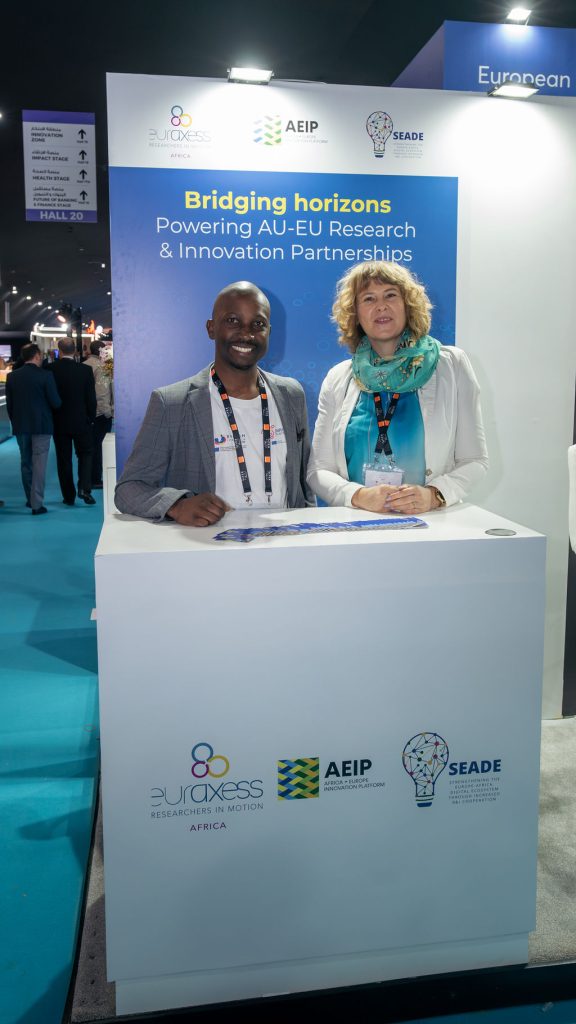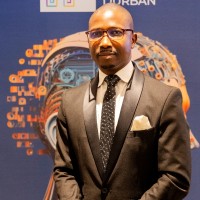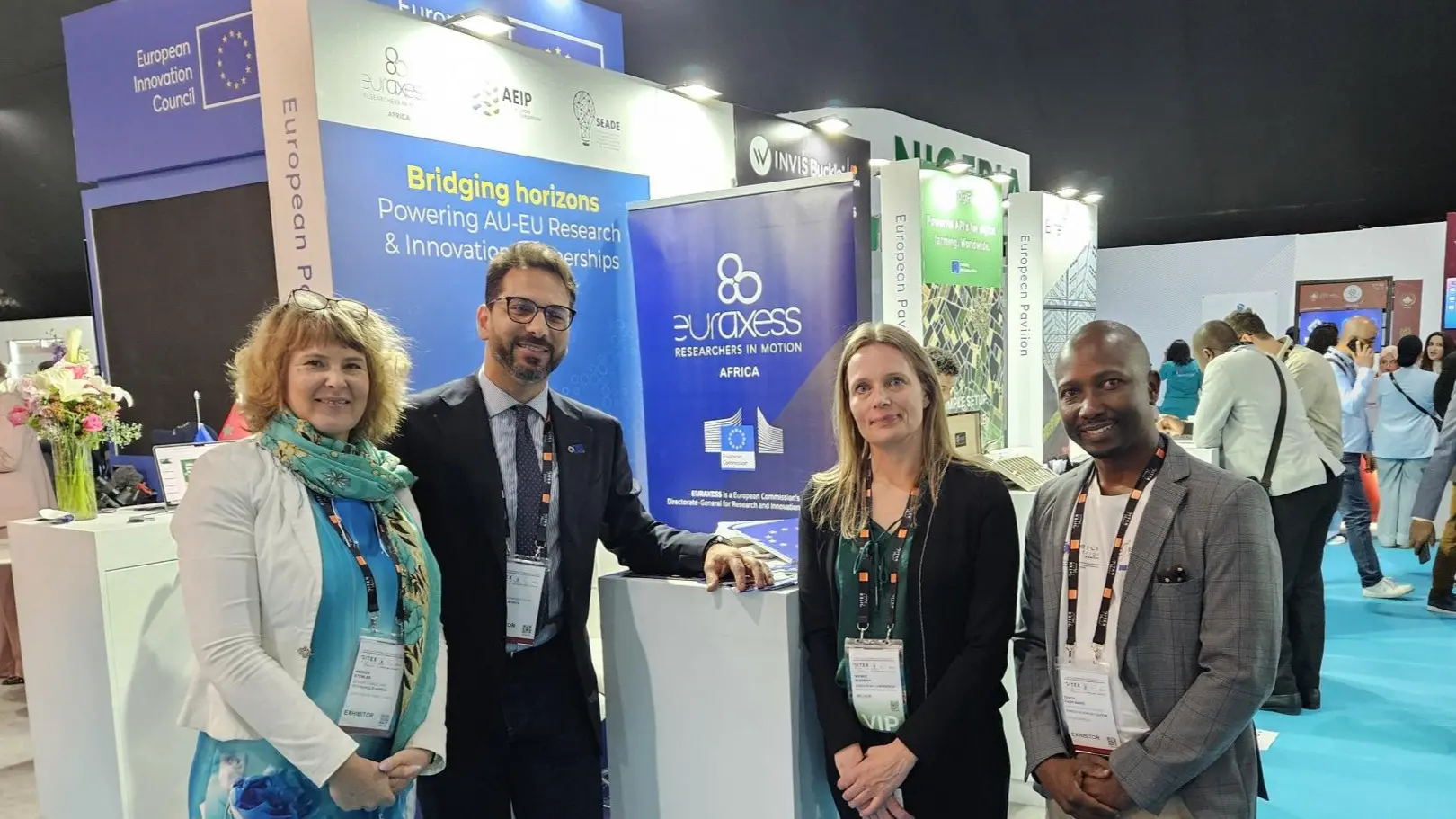Bridging continents: advancing the AU–EU innovation agenda through strategic collaboration at GITEX Morocco 2025
By Tendai Pasipamire, Partnership & Business Development Manager, Enrich in Africa Center
A unique vantage point: multiple lenses, unified vision
GITEX Morocco 2025 presented an extraordinary opportunity to witness the Africa-Europe innovation landscape from multiple perspectives simultaneously. As Business Development Manager for Enrich in Africa Center, I had the privilege of representing two complementary EC-funded initiatives—SEADE (Strengthening the Europe-Africa Digital Ecosystem), AEIP2.0 (African Union-European Union Innovation Platform), and sharing exhibition space with EuroAxxes together with Andrea Stemler Senior Consultant in M&E and international cooperation (Technopolis Africa) and Ahmed Maalel, PhD Regional representative for EURAXESS Africa —while moderating critical discussions on artificial intelligence’s role in strengthening research and innovation at the Africa-Europe interface.
Aggregation of African startup, funding, policy and R&IID support ecosystem in Morocco at GITEX Africa 2025
At GITEX Africa Morocco 2025, the aggregation of Africa’s startup, funding, policy, and R&IID support ecosystems revealed a continent in transition—ambitious, self-aware, and increasingly interconnected. The convergence of Francophone and Anglophone innovators showcased a generation of founders undeterred by infrastructure constraints, co-creating solutions from AI-powered Arabic education tools to blockchain applications for cross-border payments. More than just a tech exhibition, GITEX served as a living laboratory for the AEIP 2.0 needs assessment, a pivotal project deliverable. This exercise surfaced transnational bottlenecks, such as the persistent research-to-market gap in Francophone Africa, while exposing the disparity between actual stakeholder needs and externally imposed assumptions. These insights fundamentally shifted AEIP 2.0’s design—from a technology-first to a user-needs-first approach. Meanwhile, the VC and development funder presence underscored growing alignment around addressing cross-border investment complexity, as development aid models faced scrutiny and demand rose for partnership frameworks that recognise Africa’s evolving tech landscape.
A deeper stakeholder ecosystem analysis at the event revealed converging interests across diverse actors, providing valuable guidance for future EU–Africa innovation collaboration. Government and policy stakeholders emphasised digital transformation and capacity-building through technology transfer, while European policymakers sought scalable partnership mechanisms. Research institutions offered contrasting strengths: established centres boasted academic excellence yet lacked commercialisation experience, whereas emerging hubs were agile but in need of institutional support—highlighting the critical relevance of SEADE’s twinning activities. The private sector dialogue bridged global and local imperatives, with African startups demonstrating acute local insight and multinationals exploring responsible market entry. Innovation support organisations stood out as strategic connectors, holding the trust and networks to anchor EU-funded initiatives within communities. Yet, the under-representation of civic organisations, despite their active engagement, reaffirmed the urgency of inclusive strategies—an imperative central to AEIP’s mission to shape sustainable and inclusive locally owned innovation ecosystems
Project synergies in action: complementary strengths, amplified impact

Tendai Pasipamire and Andrea Stemler at Gitex Africa
The co-location of SEADE, AEIP, and EuroAxxes within the European Innovation Council pavilion created unexpected opportunities for demonstrating how complementary EU-funded initiatives can work in concert. It was a demonstration of how different EU initiatives navigate the same innovation ecosystem challenges from complementary angles. Rather than competing for stakeholder attention, the projects began functioning as an integrated support system. Each project brought distinct strengths that, when combined, offered visitors comprehensive support across the innovation value chain.
I watched a Rwandan biotech researcher move seamlessly from discussing technology transfer mechanisms and research-route-to-market with the SEADE team, to exploring crucial insights into researcher mobility and career development challenges with EuroAxxes Africa, before finalising partnership parameters and ecosystem matchmaking through AEIP’s collaboration framework. This wasn’t orchestrated—it emerged organically as stakeholders recognised that their complex needs couldn’t be addressed by any single initiative.
AEIP 2.0’s needs assessment methodology revolutionised traditional evaluation approaches by embedding assessment activities within authentic networking conversations, capturing real-time user requirements as stakeholders solved actual collaboration challenges. This organic approach revealed that African stakeholders fundamentally sought platform functionality that enhanced rather than replaced their existing informal networks and collaboration strategies, rejecting imposed workflows in favour of tools that supported indigenous practices. The assessment exposed widespread fatigue with Eurocentric platforms that prioritised institutional requirements over African user experiences, documenting specific barriers that informed AEIP 2.0’s user-centred design specifications. Simultaneously, AEIP’s meta-platform capabilities proved essential during stakeholder mapping exercises, with its unique capacity to connect diverse innovation ecosystem actors proving invaluable for addressing complex, multi-stakeholder challenges and facilitating promising partnerships between European research institutions and African entrepreneurs.
The synergies extended beyond individual project capabilities. The combined presence demonstrated the EU’s comprehensive approach to Africa–Europe cooperation, showcasing how different initiatives address complementary aspects of the innovation challenge. This integrated presentation strengthened credibility and provided stakeholders with clear pathways for engagement across multiple touchpoints.

“ “GITEX Morocco 2025 demonstrated the transformative potential of strategic collaboration when complementary initiatives work in concert to advance shared objectives.” „
Panel insights: AU–EU innovation agenda fourth workshop with specific focus on artificial intelligence for facilitating and strengthening research and innovation at the Africa–Europe interface AI as a catalyst for strengthened research and innovation interfaces
Moderating two panels focused on artificial intelligence’s role in facilitating Africa–Europe research collaboration provided deep insights into both opportunities and challenges facing the innovation ecosystem.
1. Experience sharing: AI in R&I and lessons from AU–EU innovation agenda
The experience-sharing panel, which was co-moderated by Andrea Stemler, revealed compelling examples of successful AI integration in research and innovation contexts, alongside valuable lessons from initiatives that are thriving amidst implementation challenges. The following EC funded startups were on the panel:
- Golden Nhunhama founder of eAgro from Zimbabwe shared on AI for Agriculture
- Hicham el Attar founder of Datapathology from Tunisia shared on AI for Medical Innovation: Transforming Pathology with Data
- Nikhil Mandrekar founder The Carbon Games from Portugal sharing on Gaming for Impact: The Role of AI in Climate and Behavioural Innovation
Critical insights emerged from the panel revealing that effective AI collaboration hinges on cultivating authentic human relationships and institutional trust rather than pursuing technological advancement in isolation, while fundamental structural obstacles—including chronically mismatched funding cycles, incompatible cross-border data governance regimes, and the need to reimagine AI solutions for resource-constrained environments—continue undermining partnership sustainability despite growing recognition that long-term success requires genuine capacity building and contextual adaptation over imposed technological transfers.
2. AI networking café: facilitating matchmaking and collaboration building
I particularly enjoyed moderating the networking café format as it proved highly effective for facilitating concrete dialogue between panelists and the hybrid participants in attendance at the workshop. Unlike traditional panel discussions, the café approach encouraged informal interactions that led to specific partnership commitments. The session identified several promising collaboration pathways, including joint research proposals, researcher exchange programmes, and technology transfer initiatives.
Participants consistently emphasised the need for dedicated matchmaking platforms that can sustain connections beyond individual events. This feedback directly informs AEIP’s platform development priorities, highlighting the importance of creating persistent collaboration mechanisms rather than relying solely on episodic networking opportunities.
Impact and outcomes: concrete results and emerging collaborations
The strategic presence of multiple EC-funded initiatives at GITEX Morocco 2025 generated measurable outcomes that advance each project’s core objectives while contributing to broader AU-EU Innovation Agenda implementation.
Immediate Outcomes included multi new stakeholder contacts across government, academia, and private sector categories.
AEIP Platform Development benefited from detailed stakeholder mapping that identified potential platform participants and clarified platform functionality requirements based on user feedback. The project initiated discussions with existing innovation platforms regarding integration opportunities, advancing the meta-platform concept.
Cross-Project Synergies and Emerging Partnerships included joint programming opportunities where SEADE’s digital capacity building could support AEIP platform preparation, and EuroAxxes’ researcher networks could strengthen both initiatives’ human capital development objectives.
Strategic recommendations: strengthening AU–EU innovation interfaces
The comprehensive engagement at GITEX Morocco 2025 generated actionable recommendations for enhancing Africa–Europe innovation collaboration through both project-specific improvements and broader strategic adjustments.
For EU-funded initiatives
- Coordination enhancement should build on the successful EIC pavilion model by creating permanent coordination mechanisms among complementary initiatives. Regular inter-project consultation could identify collaboration opportunities and avoid duplication while strengthening overall impact.
- Stakeholder engagement requires sustained presence in priority African markets rather than episodic participation in major events. Establishing local partnerships with innovation support organisations could provide continuous stakeholder access and relationship maintenance.
- Digital platform integration should prioritise interoperability among project platforms, enabling seamless user experiences across SEADE’s digital resources, AEIP’s collaboration tools, and EuroAxxes’ mobility platforms.
Conclusion: building bridges through strategic collaboration
GITEX Morocco 2025 demonstrated the transformative potential of strategic collaboration when complementary initiatives work in concert to advance shared objectives. The convergence of SEADE, AEIP, and EuroAxxes within the European Innovation Council pavilion created synergies that amplified individual project impacts while advancing broader AU–EU innovation agenda goals.
Moving forward, the insights gained at GITEX Morocco 2025 will inform programming adjustments across all three initiatives while contributing to broader understanding of effective Africa–Europe innovation collaboration. The relationships established and partnerships initiated demonstrate the enduring value of strategic presence at key regional events.
The path ahead requires sustained commitment to the collaborative principles demonstrated at GITEX Morocco 2025: respect for local priorities, commitment to inclusive participation, and recognition that innovation thrives through authentic partnership rather than traditional donor–recipient relationships. By building on these foundations, EU-funded initiatives can contribute meaningfully to Africa’s innovation ambitions while strengthening the bonds that connect our continents in pursuit of shared prosperity.


